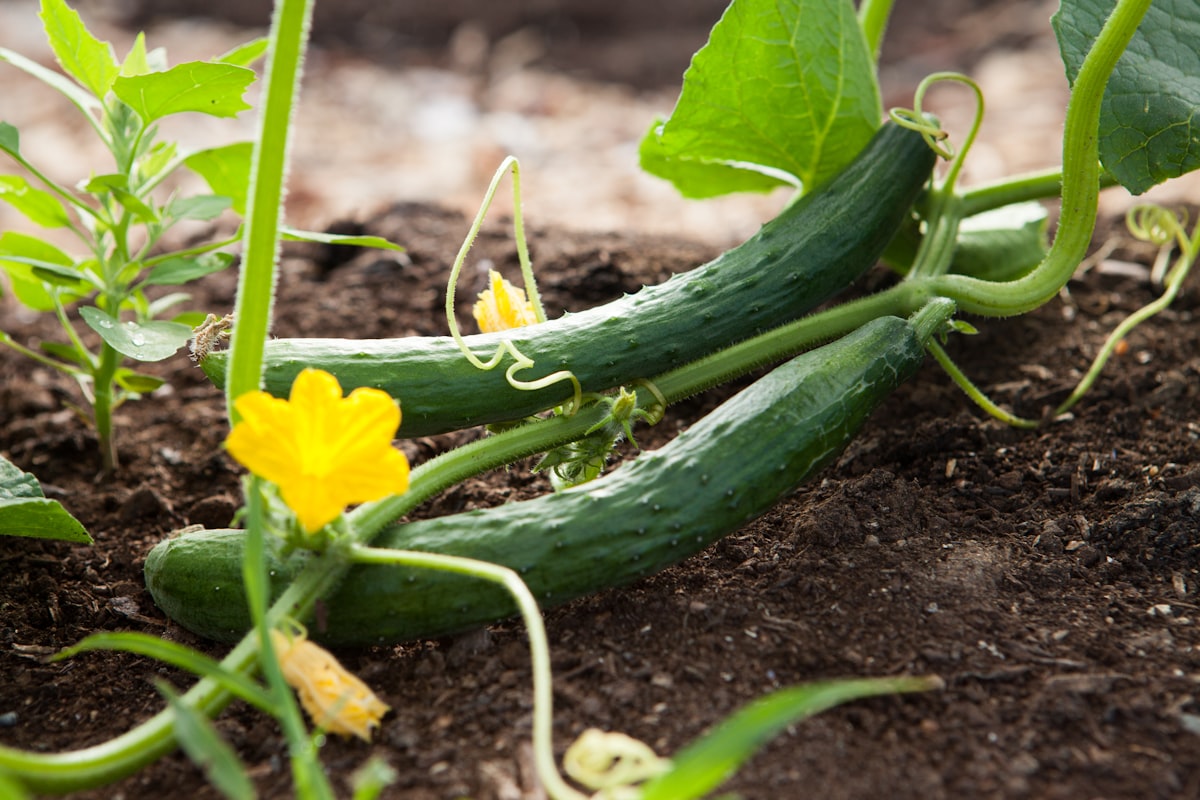How to Grow Cucumbers
Growing cucumbers can be a rewarding experience for both novice and experienced gardeners.

Table of Contents
These versatile vegetables are perfect for adding a refreshing crunch to salads, sandwiches, and even as a snack on their own.
To successfully grow cucumbers, it's essential to choose a sunny location with well-draining soil, as they are tropical vegetables that love direct sunlight.
Additionally, it's important to know the type of cucumber you're planting, as some varieties require pollinators while others are self-pollinating.
About Cucumber Plant
Cucumbers (Cucumis sativus) are a popular vegetable in the same family as melons, squash, and pumpkins.
They are easy to grow and come in various shapes and sizes, making them a favorite among gardeners.
There are numerous cucumber varieties, which can be categorized into two main types: slicers and picklers.
Slicers are larger and typically eaten fresh, while picklers are smaller and often used for pickling.
Additionally, most cucumbers are self-pollinating, ensuring a successful harvest.
Growing Cucumbers
Seeds
To start growing cucumbers, you can plant seeds directly into your garden or start seedlings indoors.
Sow cucumber seeds about 1 inch deep, 2 to 3 weeks after your last frost date.
Soil and Fertilizing
Cucumber plants thrive in well-draining, fertile soil rich in organic matter.
Before planting, mix compost, aged manure, or other organic materials into the soil and apply a granular fertilizer to provide nutrients for your plants.
Space and Containers
Cucumbers need ample space to grow, so provide 3-4 feet between vining varieties and 2-3 feet for bush types.
Choose a pot at least 12 inches deep and wide in containers to accommodate their root system.
Season and Temperature
Cucumbers are a warm-weather crop and prefer full sun exposure.
Plant them after the last frost when soil temperatures are above 60°F, and ensure they receive at least 6-8 hours of sunlight daily.
Plant Varieties
Select cucumber varieties based on your preference and growing conditions.
Some popular types include bush cucumbers for limited space, pickling cucumbers for preservation, and parthenocarpic varieties that produce fruit without pollination.
Caring for Cucumber Plant
Sun and Temperature
Cucumbers thrive in full sun and prefer temperatures between 60 to 90°F. Ensure your plants receive at least 6 hours of sunlight daily for optimal growth.
Water and Humidity
Water your cucumbers regularly, providing at least 1 inch per week, especially when fruits are present.
Maintain consistent watering to prevent bitter fruit and use mulch to help maintain soil moisture.
Soil and Fertilizing
Cucumbers grow best in fertile, well-drained soil with a pH of 6.0 to 6.8.
Improve your garden's native soil by mixing several inches of aged compost or other rich organic matter.
Fertilize your cucumber plants with an organic material, such as aged manure or granular fertilizer.
Apply fertilizer according to package instructions before planting and side-dressing during the growing season.
Pruning and Propagation
Regularly remove dead or yellowing leaves for healthier plants and better airflow.
Optionally, thin out seedlings when they reach at least four inches high and have two sets of true leaves, replanting them further apart.
Train your cucumbers to grow on a trellis or fence to ensure better air circulation, increased sun exposure, and easier harvest.
This also helps reduce the risk of disease and damage from pests.
Troubleshooting Plant Problems
Growing Problems
Cucumbers require several key conditions to grow properly. Check your garden's soil, pH, and temperature if your plants are not producing fruit or have yellowing leaves.
Ensure your cucumbers receive full sun and proper nutrients, such as compost and organic fertilizer.
Adjust your watering and nutrient levels in case of bitter-tasting fruit or excessive foliage.
Keep an eye on the size and texture of the cucumbers, as these can indicate issues with the plant's overall health.
Pests and Diseases
Cucumber plants are prone to certain pests and diseases, hindering their growth and affecting fruit quality.
Be vigilant for cucumber beetles, which spread bacterial wilt and cause significant damage to leaves and vines.
Powdery mildew is another common issue in cucumber plants and can be prevented by choosing resistant varieties or using organic methods, such as row covers and natural fungicides.
Protect your plants from frost with proper greenhouse care or protective covers.
Ensuring a clean and healthy garden environment will help prevent pests and diseases from causing harm to your cucumber plants.
Conclusion
Growing cucumbers can be rewarding, as they are relatively easy to cultivate and provide an abundant yield within 50-70 days from planting.
To succeed in your cucumber garden, plant them in an area with at least 6-8 hours of direct sunlight and provide fertile soil enriched with aged manure or compost.
Keep your cucumber plants well-watered, as this will improve their taste and prevent them from becoming bitter.
Regular watering and proper care will ensure a healthy harvest of cucumbers you can enjoy in salads or pickles.
Frequently Asked Questions
How long do cucumbers take to grow?
Cucumbers typically take 50-70 days to grow from seed to harvest. The growth duration can vary depending on the variety, so check the seed packet for specific information.
What is the ideal cucumber plant spacing?
For bush-type cucumbers, space the small hills (mounds of soil) about 3 feet apart after seeds germinate, and thin out seedlings to leave the two strongest plants in each hill.
What are the best cucumber-growing seasons?
Cucumbers thrive in warm weather and should be planted in late spring or early summer. They need temperatures consistently above 60°F, with ideal daytime temperatures ranging from 70°F to 90°F.
How much water do cucumbers need?
Cucumber plants need consistent watering, usually 1-2 inches per week.
Provide deep, thorough waterings to encourage strong root development and prevent drought stress in hot weather.
Do cucumbers require a trellis for growth?
While cucumbers can technically grow without a trellis, using one promotes healthier growth and prevents disease.
A trellis or support system makes it easier to maintain vines and helps to keep the fruit off the ground.


